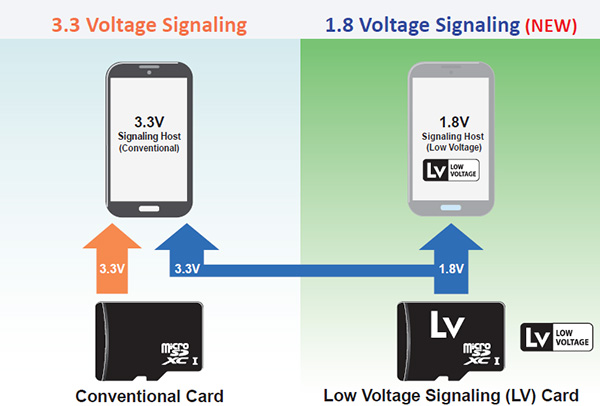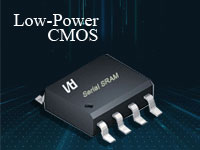Controller supports SD 6.0 spec
Silicon Motion Technology has introduced what it claims is the first merchant SD memory controller to support SD 6.0 spec and deliver a minimum random read/write performance of 4,000/2,000 IOPS.
Even though on-board storage capacity in mobile phones is steadily growing, the need for external media such as SD cards will still be there. Controller companies are leveraging their expertise in SSD to keep up in the emerging application space.
Silicon Motion Technology recently introduced what it said is the first merchant SD controller that supports the latest SD 6.0 specifications and meets the new A2 application performance rating with a minimum random read/write performance of 4,000/2,000 IOPS. The SD Specification 6.0 was announced earlier this year at the Mobile World Congress by the SD Association (SDA). It expands support for mobile devices with Application Performance Class 2 (A2) more than doubling random read and write speeds guaranteed in the entry level App Performance Class 1 (A1), which was announced late last year.
In a telephone interview with EE Times, Robert Fan, U.S. general manager at Silicon Motion, said the company's latest SD controllers demonstrate the evolution of the storage media as they must support bandwidth-intensive applications such as 4K video recording and playback and AR/VR, as well as better random read and write performance. Expandable memory cards with Silicon Motion's new controller will also provide sufficient performance so users can run Android 6.x/7.x applications directly from their cards.
While there's been plenty of speculation over the years that SD cards and other removable cards would fade away, Fan said the opposite is true, even as smartphones gain more on-board storage capacity. “The non-iPhone market has grown, especially in China,” Fan said.
Phones with SD card slots rather than large amounts of on-board storage reduce the cost of out of the box, he said, letting users decide how much capacity they want to add. “The microSD card market has been fairly resolute over the years," he said. It's not just smartphones that continue to demand SD cards—particularly microSD cards—Fan said. Silicon Motion's SD 6.0 controller supports the low voltage signalling requirements, low-power SoCs and feature command queue, cache function and self-maintenance capabilities that enable high-performance, high-reliability and long endurance expandable memory cards. The new controllers are available in both commercial and industrial temperature grades, he said, which makes them for suitable for automotive applications such as infotainment systems. Other emerging applications for SD cards influencing controller development include surveillance and body cameras, as well as drones.
Meanwhile, SD card controllers are following in the footsteps of those for SSDs or embedded memory in that the critical features are similar, said Fan, as is the need to manage large amounts of data. Silicon Motion's SD 6.0 controller supports up to 2TB capacity, for example. He said the SDA, of which Silicon Motion is a highly active participant, has continued to evolve the specifications. While 4.0 was very much about increased performance in general, more recent updates including 6.0 have had more focus on higher random performance, as well as support for embedded features. “Those are things that are designed into the silicon as well as the firmware that runs on the silicon," Fan said.

Figure 1: The SD specification 6.0 includes updated low voltage signaling features to meet the latest low-power mobile chipset requirements.
Not only do controllers need to support the latest features in the SD specifications, they must support the latest NAND technology and anticipate future NAND requirements, said Fan. “We're looking at two areas of innovation where controllers play a role: the evolution of the SD card in terms of features, applications, and performance; the other side of controllers is they need to bridge the gap between the application and the NAND technology evolution.”
SDA president Brian Kumagai said there continues to be a chicken and egg dynamic with SD cards and controllers. “The SDA creates new standards and features, but it's really up to controller vendor to implement all of these features and get speeds that specs are calling for," Kumagai added. What keeps the ecosystem evolving is the active participation of SD controller company executives in the SDA.
Kumagai said controller development has been key to the advancement of specifications, particularly 5.0 and 6.0, where there has been more focus on random performance and command queue functions. “We're implementing a lot of things that were more prevalent in SSDs,” he said. “The know-how is a differentiator for controller developers.”
The SDA continues to see growth and new opportunities for SD cards, particularly A2 microSDs for mobile devices, even if the cards and interface end up changing dramatically. Kumagai said more people are realising the benefits of the standards and of the microSD form factor, including automotive and surveillance applications, especially as a fully embedded option can be too cost-prohibitive to accommodate the sheer volume of photos and 4K video. “I don't think anything with will replace the microSD at this point,” Kumagai said.
Even though on-board storage capacity in mobile phones is steadily growing, the need for external media such as SD cards will still be there. Controller companies are leveraging their expertise in SSD to keep up in the emerging application space.
Silicon Motion Technology recently introduced what it said is the first merchant SD controller that supports the latest SD 6.0 specifications and meets the new A2 application performance rating with a minimum random read/write performance of 4,000/2,000 IOPS. The SD Specification 6.0 was announced earlier this year at the Mobile World Congress by the SD Association (SDA). It expands support for mobile devices with Application Performance Class 2 (A2) more than doubling random read and write speeds guaranteed in the entry level App Performance Class 1 (A1), which was announced late last year.
In a telephone interview with EE Times, Robert Fan, U.S. general manager at Silicon Motion, said the company's latest SD controllers demonstrate the evolution of the storage media as they must support bandwidth-intensive applications such as 4K video recording and playback and AR/VR, as well as better random read and write performance. Expandable memory cards with Silicon Motion's new controller will also provide sufficient performance so users can run Android 6.x/7.x applications directly from their cards.
While there's been plenty of speculation over the years that SD cards and other removable cards would fade away, Fan said the opposite is true, even as smartphones gain more on-board storage capacity. “The non-iPhone market has grown, especially in China,” Fan said.
Phones with SD card slots rather than large amounts of on-board storage reduce the cost of out of the box, he said, letting users decide how much capacity they want to add. “The microSD card market has been fairly resolute over the years," he said. It's not just smartphones that continue to demand SD cards—particularly microSD cards—Fan said. Silicon Motion's SD 6.0 controller supports the low voltage signalling requirements, low-power SoCs and feature command queue, cache function and self-maintenance capabilities that enable high-performance, high-reliability and long endurance expandable memory cards. The new controllers are available in both commercial and industrial temperature grades, he said, which makes them for suitable for automotive applications such as infotainment systems. Other emerging applications for SD cards influencing controller development include surveillance and body cameras, as well as drones.
Meanwhile, SD card controllers are following in the footsteps of those for SSDs or embedded memory in that the critical features are similar, said Fan, as is the need to manage large amounts of data. Silicon Motion's SD 6.0 controller supports up to 2TB capacity, for example. He said the SDA, of which Silicon Motion is a highly active participant, has continued to evolve the specifications. While 4.0 was very much about increased performance in general, more recent updates including 6.0 have had more focus on higher random performance, as well as support for embedded features. “Those are things that are designed into the silicon as well as the firmware that runs on the silicon," Fan said.

Figure 1: The SD specification 6.0 includes updated low voltage signaling features to meet the latest low-power mobile chipset requirements.
Not only do controllers need to support the latest features in the SD specifications, they must support the latest NAND technology and anticipate future NAND requirements, said Fan. “We're looking at two areas of innovation where controllers play a role: the evolution of the SD card in terms of features, applications, and performance; the other side of controllers is they need to bridge the gap between the application and the NAND technology evolution.”
SDA president Brian Kumagai said there continues to be a chicken and egg dynamic with SD cards and controllers. “The SDA creates new standards and features, but it's really up to controller vendor to implement all of these features and get speeds that specs are calling for," Kumagai added. What keeps the ecosystem evolving is the active participation of SD controller company executives in the SDA.
Kumagai said controller development has been key to the advancement of specifications, particularly 5.0 and 6.0, where there has been more focus on random performance and command queue functions. “We're implementing a lot of things that were more prevalent in SSDs,” he said. “The know-how is a differentiator for controller developers.”
The SDA continues to see growth and new opportunities for SD cards, particularly A2 microSDs for mobile devices, even if the cards and interface end up changing dramatically. Kumagai said more people are realising the benefits of the standards and of the microSD form factor, including automotive and surveillance applications, especially as a fully embedded option can be too cost-prohibitive to accommodate the sheer volume of photos and 4K video. “I don't think anything with will replace the microSD at this point,” Kumagai said.
CONTACT US
USA
Vilsion Technology Inc.
36S 18th AVE Suite A,Brington,Colorado 80601,
United States
E-mail:sales@vilsion.com
Europe
Memeler Strasse 30 Haan,D 42781Germany
E-mail:sales@vilsion.com
Middle Eastern
Zarchin 10St.Raanana,43662 Israel
Zarchin 10St.Raanana,43662 Israel
E-mail:peter@vilsion.com
African
65 Oude Kaap, Estates Cnr, Elm & Poplar Streets
Dowerglen,1609 South Africa
E-mail:amy@vilsion.com
Asian
583 Orchard Road, #19-01 Forum,Singapore,
238884 Singapore
238884 Singapore
E-mail:steven@vilsion.com
